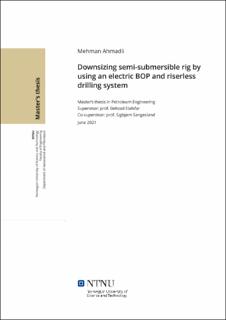| dc.contributor.advisor | Elahifar, Behzad | |
| dc.contributor.advisor | Sangesland, Sigbjørn | |
| dc.contributor.author | Ahmadli, Mehman | |
| dc.date.accessioned | 2021-09-24T18:10:00Z | |
| dc.date.available | 2021-09-24T18:10:00Z | |
| dc.date.issued | 2021 | |
| dc.identifier | no.ntnu:inspera:85047365:48611382 | |
| dc.identifier.uri | https://hdl.handle.net/11250/2781641 | |
| dc.description.abstract | Sammenlignet med andre sektorer er petroleumsindustrien mer konservativ for å gjøre betydelige endringer, og for å tilpasse ny teknologi. Olje- og gasselskapene foretrekker å holde seg til de tradisjonelle og velprøvde metodene. Imidlertid er det også riktig at de enkelte utfordringene bringer nye metoder og teknikker til petroleumsindustrien (f.eks. fremskritt innen retnings- og horisontal boring på Troll-feltet, Norge). Nå er det igjen tid for borebransjen å åpne en ny side. Fremtidig global etterspørsel vil komme fra fra ultra-dypt vann. Konvensjonell boreoperasjon ved bruk av standard systemer og utstyr vil være en utfordring på grunn av økende størrelse og vekt på BOP og marint borestigerør, og dermed tilhørende stort og kostbart boreskip.
For å overvinne de ovennevnte utfordringene og redusere størrelse og vekt på borefartøyet, er det i denne masteroppgaven fokusert et nytt system for boring, og vil bli referert til som Riserless Drilling (RD) system. I utformingen av RD-systemet er alt hydraulisk system i BOP, marine stigerør og tilhørende riggutstyr eliminert. I stedet er det elektriske styresystemet og aktuatorene integrert, noe som gir bedre effektivitet, holdbarhet, pålitelighet, oppfølging, kontinuerlig overvåking, vedlikeholdsinngang, hastighet og momentkontroll, autonom kontroll med CPU-enhet og viktigst av alt, en kostnadsbesparende løsning. Det store 21 tommers marine stigerøret erstattes av slamreturlinje som er lettere og mindre i diameter. Bare en BOP-oppdatering muliggjør 140 mT vektreduksjon og 1051 ft2 plassbesparelse fartøyet, mens ved å eliminere det marine store stigerøret, blir besparelse i riggområdet ca. 3600 ft2.
Bortsett fra CAPEX-reduksjonen i det nye RD-systemet, reduseres også OPEX på grunn av kortere riggtid og mindre nedetid (NPT). Rapporten sammenligner en typisk BOP-vedlikeholdsoperasjon i CRD og det nye RD-systemet, og konkluderer med at sistnevnte muliggjør 2,550,000 USD kostnadsreduksjon for bare en operasjon. Med tanke på de betydelige fordelene som det nye RD-systemet gir, kan vi være vitne til store endringer i fremtidig boreoperasjon. Imidlertid krever konseptet betydelig utvikling, inkludert subsea pumpe system og en sikker løsning for brønnkontroll, etc. | |
| dc.description.abstract | In comparison with the other sectors, the petroleum industry is more resistive to significant changes, and to adapt new technologies. The oil- and gas companies prefer to stay with the traditional and well proven methods. However, it is also true that the individual challenges are bringing new methods and techniques to the petroleum industry (e.g., advances in directional- and horizontal drilling on the Troll field, Norway). Now, it is again a time for the drilling industry to open a new page. Future global demand will be provided from ultra-deep-water reservoirs. Conventional drilling operation using standard systems and equipment will be a challenge due to increasing size & weight of the BOP and marine drilling riser system, and thus the requirement for large and costly drilling vessel.
To overcome the above-mentioned challenges and to downsize the semi-submersible rig, this master’s thesis report deals with a new system for drilling, which will be referred as a Riserless Drilling (RD) system. In the design of the RD system, all hydraulic system of the BOP, marine riser and their associated rig equipment are eliminated. Instead, electric control system and actuators have been integrated, which offers efficiency, durability, reliability, follow-up inputs, continuous monitoring, maintenance input, speed-torque control, autonomous control by CPU unit, and most importantly cost-saving solution. Heavy and large marine riser is replaced by mud return line which is lighter and smaller in diameter. Just a BOP update offers 140 mT weight reduction and 1051 ft2 rig space saving, while by counting the elimination of the marine riser, this figure is multiplied to 3600 ft2 saving in the rig area.
Apart from the CAPEX reduction in the new RD system, OPEX is also decreased due to shorter rig time and less down time (NPT). The report compares a typical BOP maintenance operation in the CRD and new RD system, and concludes that the latter one offers 2,550,000 USD cost reduction in just one operation. Considering the significant advantages that the new RD system offers, we can witness major changes in future drilling operation. However, the concept requires significant development including subsea boosting system and a safe well control solution, etc. | |
| dc.language | eng | |
| dc.publisher | NTNU | |
| dc.title | Downsizing semi-submersible rig by using an electric BOP and riserless drilling system | |
| dc.type | Master thesis | |
